|
|
|
final report
Traffic Congestion and Reliability: Linking Solutions to Problems
3.0 National State of Congestion: Congestion by the Numbers and Why It Matters
3.1 TRENDS IN NATIONAL CONGESTION
Is congestion getting worse? Yes. The best single source for monitoring congestion trends is produced annually by the Texas Transportation Institute (TTI).15 In their 2003 report, TTI's researchers found that congestion levels in 75 of the largest metropolitan areas have grown continuously in almost every year in all population groups from 1982 to 2001, as exemplified by the following trends.
Eleven-Year Average Trends (Urban Travel, 1990 to 2001)
- Peak-period16 trips take an average of about 10 percent longer.
- Travelers spend 51 extra hours per year in travel compared to 42 hours in 1990.
- The percent of freeway mileage that is congested has grown from 49 percent to 60 percent.
Nineteen-Year Trends (Urban Travel, 1982 to 2001)
- "Congestion extends to more time of the day, more roads, affects more of the travel, and creates more extra travel time than in the past. And congestion levels have risen in all size categories, indicating that even the smaller areas are not able to keep pace with rising demand."
- Twenty-seven urban areas have a Travel Time Index17 above 1.30 compared with one such area in 1982.
- Sixty-seven percent of the peak-period travel is congested compared to 33 percent in 1982. Each traveler in the top 75 urban areas spent an average of 51 hours per year stuck in traffic in 2001, up from 17 hours in 1982.
- Sixty percent of the major road system is congested compared to 34 percent in 1982.
- The number of hours of the day when travelers might encounter congestion has grown from 4.5 hours to 7 hours.
Why Is This a Problem?
- Congestion isolates people from other activities, such as business, recreation, and family time.
- Congestion results in a less productive work force. Except for the distracted drivers chatting on their cell phones, drivers are not very productive while commuting. And too often they are tense and frustrated when they get to work.
- Service workers do not make as many calls per day if they spend extra time in stop-and-go traffic. This is particularly important for emergency medical, fire, and police services which may be unnecessarily delayed from attending to medical, crime, and disaster situations.
- Congestion leads to increased fuel consumption and automobile emissions (because vehicles are operating less efficiently).
- Congestion caused by unexpected events leads to increased vehicle crashes. When traffic incidents occur, congestion often appears in places where motorists are not expecting it. Rubbernecking and conflicts with emergency vehicles just make the problem worse. Work zones present unexpected changes in highway alignment and other features. By reducing how long traffic incidents and work zones last, we are not only reducing congestion and improving reliability, but making it safer for travelers as well.
- Companies with production schedules timed to take advantage of trucks delivering components to an assembly line as they are needed must instead plan for items to arrive early. This consumes space and inventory, expending resources that could otherwise be spent on productive activity.
Congestion has clearly grown. Congestion used to mean it took longer to get to/from work in the "rush hour." It used to be thought of as a big city issue or an item to plan for while traveling to special large events (Figure 3.1). Sure there was slower traffic in small cities, but it was not much more than a minor inconvenience. The problems that smaller cities faced were about connections to and between cities, manufacturing plants, and markets.
Figure 3.1 Peak-Period Congestion (Travel Time Index) Trends by U.S. Population Group
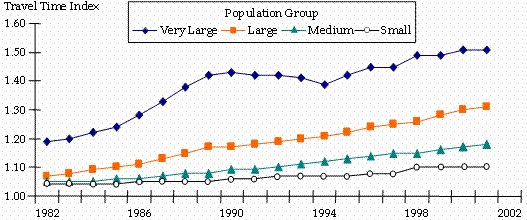
Source: Reference (1). The Travel Time Index is a measure of the total amount of congestion. It is the ratio of the weekday peak-period travel time to the travel time under ideal conditions. A Travel Time Index value of 1.3 indicates that peak-period travel takes 30 percent longer than under ideal conditions. Population groups are: Very Large ( greater than three million); Large (one to three million); Medium (500 thousand to one million); Small (less than 500 thousand).
As the economy and lifestyles have changed over the past two decades, congestion is an element that is more often thought of during the planning stages. Maybe that is the measure of the age we live in, with more meetings and child activities to arrange. Congestion effects also are reflected in decisions about business location and expansion, home and job sites, school, doctor visits, recreation, and social events and even who you date. 18 But it also is due to the fact that congestion affects more trips, more hours of the day and more of the transportation system (Figure 3.2). Congestion is affecting not only weekday commuter travel but several other types of travel: weekend travel in suburban shopping areas, travel near major recreational areas, and travel related to special events (such as sporting events).
Consider the following characteristics of congestion trends:
- Congestion affects more of the system. You might encounter stop-and-go traffic on any major street or freeway. Congestion effects have spread to neighborhoods, where cities and residents have developed elaborate plans and innovative techniques to make it harder for commuters to use the streets where kids play as bypass routes for gridlocked intersections.
- Congestion affects more time of the day. We are not just seeing these problems in the "rush hour." Peak periods typically stretch for two or three hours in the morning and evening in metro areas around one million people (Figure 3.3). Larger areas can see three or four hours of peak conditions.
These are just the average conditions. Many cities have a few places where any daylight hour might see stop-and-go traffic. Weekend traffic delays have become a problem in recreational areas, near major shopping centers or sports arenas and in some constrained roadways.
Figure 3.2 Weekday Peak-Period Congestion Has Grown in Several Ways in the Past 20 Years in Our Largest Cities
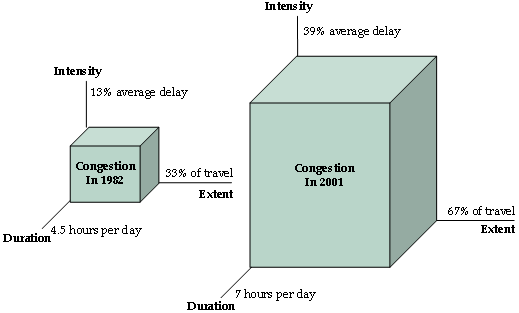
Source: Analysis of data used in 2003 Annual Urban Mobility Report, Texas Transportation Institute.
Figure 3.3 How Many Rush Hours in a Day?
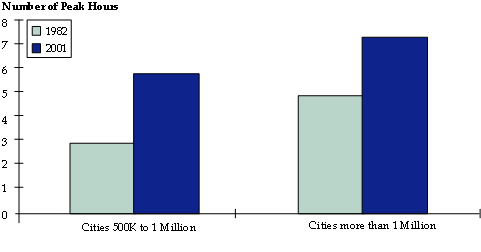
Source: Analysis of data used in 2003 Annual Urban Mobility Report, Texas Transportation Institute.
- The extra travel time penalty has grown. It just takes longer to get to your destination (Figure 3.4). Not just work or school, but shopping trips, doctor visits and family outings are planned around the questions "How long do I want to spend in the car, bus or train?" and "Is it worth it?" Peak-period trips required 39 percent more travel time in 2001 than a free flow trip at midday, up from 28 percent 10 years earlier.
Figure 3.4 In-Vehicle Travel Times for Peak-Hour Trips Have Grown Substantially in Large Cities
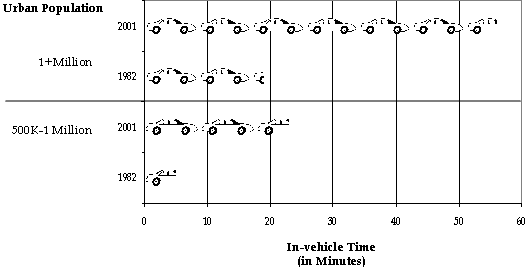
Source: Analysis of data used in 2003 Annual Urban Mobility Report, Texas Transportation Institute.
Travel Reliability is getting worse. There really is a fourth characteristic to the congestion problem — Reliability. The extra travel time and amount of the day and system affected by travel delays is not the same every day. It may not even be as it was predicted 10 minutes ago (Figure 3.5).
Figure 3.5 Travel Time Reliability Illustration
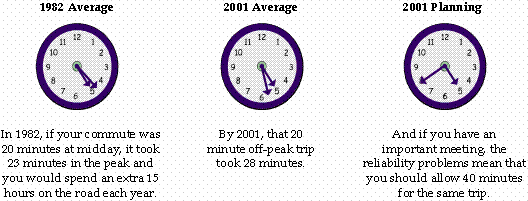
Source: Analysis of data used in 2003 Annual Urban Mobility Report, Texas Transportation Institute.
- 1982 – If your midday trip took 20 minutes, it would take you 23 minutes in the peak. Although no reliability statistics exist from that long ago, analysis of recent data suggest that you would have to add an additional nine minutes to that trip to guarantee on-time arrival at your destination; a total of 32 minutes would be planned for that trip.
- 2001 – By 2001, that 20-minute free-flow trip took 28 minutes.
- 2001 (Planning Time) – And if on-time arrival was important you should allow 40 minutes for that trip.
Why is Congestion Getting Worse and Where Is It Headed? Highway travel in the United States has been increasing at about two to three percent per year for the past decade; barring serious upheavals in the economy, growth is expected to continue but perhaps at a slower pace. This growth comes on top of a highway system which in many cities already is congested. To understand how congestion grows, consider the following. As traffic volumes rise, speeds stay near the speed limit. It may feel more crowded, but drivers do not slow down. Capacity on a freeway lane is between 2,050 and 2,200 vehicles in an hour (allowing for some trucks); only the last few hundred cars result in any speed decline. As vehicles in an hour reach the upper limit of capacity, speeds drop to a stop-and-go condition. As if that was not enough of a problem, the number of cars carried on the road also drops. So, fewer cars and trucks can use each lane, and once they do begin traveling, it is at a slower speed. This is one of the reasons the economic price of congestion is so high. Congestion robs part of the value of highway investment by causing the highway's capacity to be diminished below the capacity it is capable of conveying. Congestion, in other words, creates massive social and investment inefficiency by actually diminishing the performance capacity of an existing infrastructure asset.
The future holds more of the same. Population and employment growth in America's large cities are expected to continue rising by around two percent each year, resulting in longer periods of congestion on more of the transportation system. Tables 3.1 and 3.2 present forecasts of population and economic activity — strong drivers of transportation activity — along with forecasts of system-level transportation activity. The tables show that compared to year 2000:
- By 2025, the U.S. population will grow by 26 percent;
- By 2025, the Gross National Product will double;
- By 2025, passenger-miles (all modes, including highway, air, and transit) will grow by 72 percent; and
- By 2020, intercity truck tonnage will grow by 75 percent.
| Activity | 2000 | 2010 | 2025 |
|---|---|---|---|
| Population (millions) | 276 | 309 | 347 |
| GDP ($2000 billion) | 9,834 | 13,043 | 19,816 |
| Vehicle-Miles (billions) | 2,424 | 3,041 | 4,173 |
| Licensed Drivers (millions) | 213 | 244 | 274 |
| Vehicles (millions) | 215 | 262 | 326 |
Source: U.S. Department of Transportation, Bureau of Transportation Statistics, http://www.eia.doe.gov/.
| Tons (Millions) | |||
|---|---|---|---|
| Mode of Travel | 1998 | 2010 | 2020 |
| Total | 15,271 | 21,376 | 25,848 |
| Domestic | |||
| Air | 9 | 18 | 26 |
| Highway | 10,439 | 14,930 | 18,130 |
| Rail | 1,954 | 2,528 | 2,894 |
| Water | 1,082 | 1,345 | 1,487 |
| Total, Domestic | 13,484 | 18,820 | 22,537 |
| International | |||
| Air | 9 | 16 | 24 |
| Highway | 419 | 733 | 1,069 |
| Rail | 358 | 518 | 699 |
| Water | 136 | 199 | 260 |
| Other (including pipeline) | 864 | 1,090 | 1,259 |
| Total, International | 1,787 | 2,556 | 3,311 |
Source: FHWA Freight Analysis Framework, http://www.ops.fhwa.dot.gov/freight/freight_news/FAF/talkingfreight_faf.htm.
Keeping up with this increased demand for transportation services will be extremely challenging, and will require new ways of thinking about the problem. For highway travel alone, addressing the growth in demand will be particularly tricky. Figure 3.6 shows the effect of different growth rates for travel (as measured by vehicle-miles of travel) on congestion (as measured by the Travel Time Index, or TTI). The effect of adding increased demand on top of an already congested peak-period highway system can be easily seen — note the steep growth in congestion for the two percent per year growth compared to the 0.5 percent growth. These forecasts assume that no improvements to the transportation system will be made over the 2002 to 2010 period, which is clearly not the case. However, they can be used to illustrate two significant points about congestion growth:
- The effect of "doing nothing" to the transportation system is probably intolerable. Under the two percent VMT growth rate — roughly a continuation of recent trends — peak-period congestion will worsen substantially.
- The effect of strategies aimed at controlling VMT growth — and controlling congestion in general — can have a dramatic impact on controlling congestion growth. Strategies that reduce VMT directly (such as demand management controls discussed in the next section) can lead to a substantial slowdown in congestion growth. Likewise, congestion mitigation strategies can have the same effect by increasing physical capacity, shifting demand, and improving roadway operations. In other words, congestion mitigation strategies can produce the same effect as reduced VMT growth. When used in combination, demand management and mitigation strategies can have a powerful impact on congestion growth.
Figure 3.6 Projected Growth in Urban Freeway Congestion
(Bottleneck-Related) under Different VMT Growth Rates, 2002-2010 (Top 78 Metro Areas)
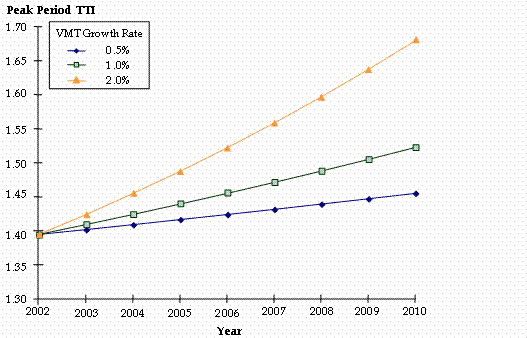
Source: Analysis of 2002 HPMS data using the Surface Transportation Efficiency Analysis Model (STEAM) delay relationships (https://www.fhwa.dot.gov/steam/). The analysis assumes that no additional highway improvements are made. The Travel Time Index (TTI) is a measure of total congestion. It is the ratio of the peak-period travel time to the travel time under ideal conditions. A TTI value of 1.4 indicates that peak-period travel takes 40 percent longer than under ideal conditions.
What Are the Trends in Reliability at the Metropolitan Level? Only recently have we defined reliability and started to measure it. Part of the problem is related to the availability of data. Because reliability is defined by how travel times vary, a continuous history of travel times is needed to measure it. Archived data from traffic management centers are starting to be used for this purpose. Figure 3.7 shows travel time and reliability statistics from 2001 and 2002. Although it is difficult to note trends with only two years of data, this is just the beginning of our monitoring of reliability. As we begin to track more cities for more years, we will be able to observe long-term changes in reliability.
Figure 3.7 Travel Time and Reliability Trends
2001-2002

Source: Analysis of data from FHWA's Mobility Monitoring Program. The Travel Time Index (TTI) is a measure of total congestion. It is the ratio of the peak period travel time to the travel time under ideal conditions. A TTI value of 1.2 indicates that peak period travel takes 20 percent longer than under ideal conditions. PTI is the Planning Time Index, the 95th percentile of the Travel Time Index. BTI is the Buffer Time Index. (See Appendix for definitions.) All are shown for individual days. The "-Month" indices are monthly averages and are shown to smooth out the trends. Although weekends and holidays are excluded, days next to holidays show light peak-period traffic characteristics (e.g., July 5). Note the upturn in peak period delay and unreliability in the Autumn months as vacationing travelers return to work and school. Note also that as the Travel Time Index increases, so does unreliable travel.
Is Congestion Growing in Medium and Small Cities as well as Rural Areas? For the time being, most of the congestion outside of cities is related to work zones, poor weather, and traffic incidents. This rural congestion is very small compared to that experienced in metropolitan areas. However, there are indications that this could change considerably.
Demand for freight transportation in the United States is expected to grow substantially over the next 15 years. Figure 3.8 displays this dramatic expected growth. The most striking growth is expected to be on rural Interstate highways, indicating the potential for congestion to spread outside of metropolitan areas. The potential for non-metropolitan congestion is further indicated by the growth in total traffic on rural Interstates over the past decade. Since 1992, traffic has grown substantially on rural highways and at a faster pace than on metropolitan highways. Table 3.3 shows that between 1992 and 2002, traffic on rural Interstates increased 36 percent compared with an increase of 26 percent on urban Interstates. Further analysis shows that traffic volumes per available lane increased by 35 percent on rural Interstates compared with 23 percent on urban Interstates.
Figure 3.8 Percentage of Highway Segments with over 10,000 Trucks Per Day, Comparison of 1998 to 2020
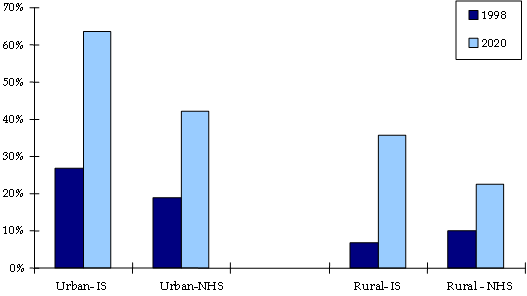
Source: Analysis of data from the Freight Analysis Framework.
| Traffic Statistic | Rural Interstate Growth | Urban Interstate Growth |
|---|---|---|
| Total Daily Volume | +36% | +25% |
| Daily Volume per Traffic Lane | +35% | +21% |
Source: Analysis of Highway Performance Monitoring System data.
Forecasts of future traffic on the National Highway System demonstrate the magnitude of this problem, assuming that the existing highway system is not improved by 2020. Specifically, by comparing Figures 3.9 and 3.10 side-by-side, it is apparent that the congestion-causing potential for trucks is great. Without trucks, most congestion would reside within major metropolitan areas (Figure 3.9). When trucks are added to the highway system, congestion spreads into what are now essentially rural corridors (Figure 3.10).19
Analysis of major urban bottlenecks with regard to trucks also is revealing (Figure 3.11). This analysis used the bottleneck locations identified in the recent American Highway Users Alliance study along with the same truck forecasts used in Figures 3.9 and 3.10 at these locations. When trucks are removed from these bottlenecks, delay is substantially reduced, but is still present at relatively high levels. Since these bottlenecks are dominated by weekday commuter traffic, this is to be expected. Trucks can be expected to have a greater proportional effect on congestion where bottlenecks are located in smaller urban, urban fringe, and rural areas.
In addition to these bottlenecks which are primarily related to mixing urban commuting and trucking, bottlenecks that primarily affect trucks also exist. These include border crossings with Canada and Mexico and local access highways to intermodal facilities, such as ports. In fact, a recent study of border crossings indicates that trucks can be delayed on average 30 minutes each time they try to cross from Mexico into the United States.20 Border delays — and the increased transportation costs they create — can seriously affect international trade between the United States and Canada and Mexico. Also, because trade is increasing between Canada and Mexico, delay to shipments on interior U.S. highways increases the costs of performing this trade. In essence, congestion on U.S. highways has become an international — not just a national — problem.
Figure 3.9 2020 Congestion Forecasts, No Trucks
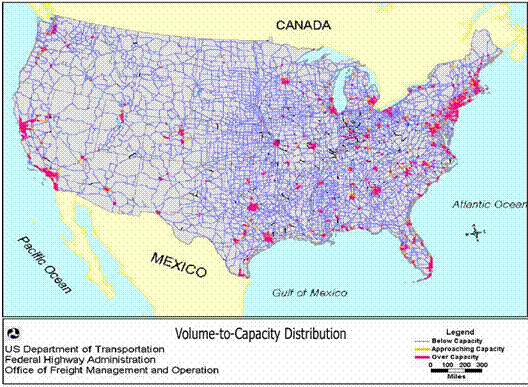
Figure 3.10 2020 Congestion Forecasts, With Trucks
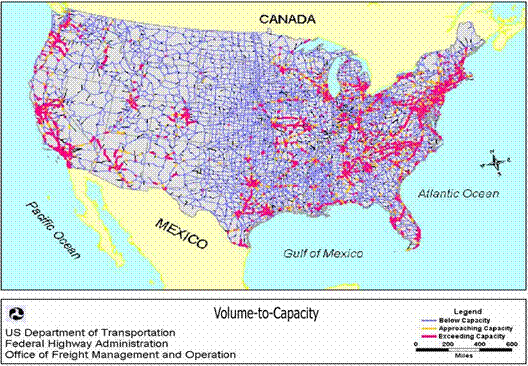
Figure 3.11 Effect of Trucks on Delay at the 50 Worst
Urban Bottlenecks
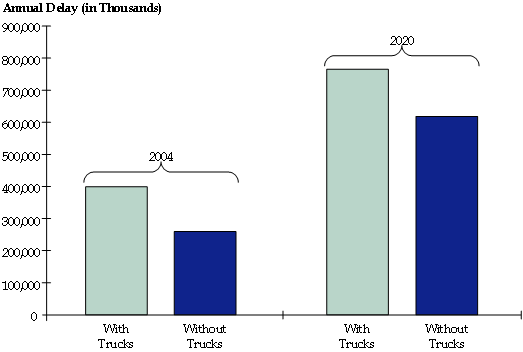
Source: Unclogging America's Arteries, American Highway Users Alliance, 2004 and analysis of Freight Analysis Framework data.
3.2 CONGESTION AND EVERYDAY LIFE
Transportation professionals tend to think of congestion in aggregate terms — congestion is a "system" problem that happens on our highway system. Yet every day, travelers are faced with the consequences of congestion and must manage their daily activities around it. In this section, we explore how congestion affects everyday life in the United States.
1. A Traveler's-Eye View of Reliability
The statistics and measures presented earlier offer transportation professionals insight into the nature of travel time reliability. However, travelers probably take a slightly different view of the situation. Returning to the data from I 75 in central Atlanta used earlier in Section 2.0, we take a more traveler-oriented perspective on travel times in the corridor. Consider a traveler who has the flexibility to adjust his or her work schedule so that they can be traveling the corridor either at 3:00 p.m. or 5:30 p.m. on most days (Figure 3.12).
Figure 3.12 Travel Times in Central Atlanta, I-75 Southbound
I-85 to I-20
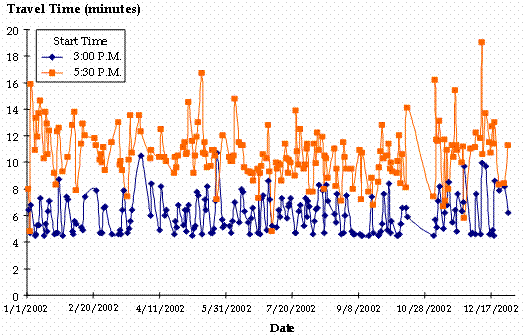
Source: Analysis of data from FHWA's Mobility Monitoring Program. The highway segment covered is 4.05 miles long. Travel times are for trips that begin at the northern end of the corridor starting at 3:00 p.m. and 5:30 p.m., traveling south. Trips that begin at 3:00 p.m. take less time to make it through the corridor AND are more reliable (less "noise" in their day-to-day fluctuations).
From these data, it is clear that travel at 3:00 p.m. is both less congested and more reliable (less variable). In other words, the traveler can better predict what travel time will be at 3:00 p.m. than at 5:30 p.m. Why is this important? If a commuter has a routine activity that must occur every day — such as picking up children from day-care — it means that at 5:30 p.m. they must plan on an extra amount of trip time just to be sure they do not arrive late. The same goes for local trucking firms engaged in pickup and delivery of goods.
Savvy commuters also understand that some days predictably are worse than others. Figure 3.13 shows the average travel and the 95th percentile travel time (the Planning Time Index) by day of week for this four-mile corridor. Fridays are clearly the worst, and if travelers must plan on a travel time of 14 minutes (average speed of 17 mph) just to be reasonably safe. It is also easy to predict that congestion and unreliable travel times will be worse than normal on days when adverse weather (snow, rain, fog, etc.) occurs.
Figure 3.13 Central Atlanta, I-75 Southbound
Weekdays between 4:00 and 7:00 p.m.
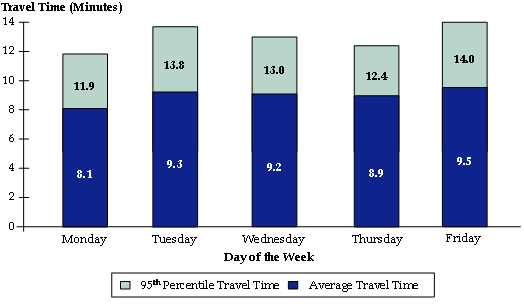
Source: Analysis of data from FHWA's Mobility Monitoring Program. The 95th percentile travel time indicates what travel time is on some of the "worst traffic days."
2. Local Businesses Learn to Deal with Congestion
Travel time reliability problems only get worse as the system gets more congested. People react by trying to alter their trip departure time or route. Businesses might increase the number of delivery trucks, or move their product overnight or in the middle of the day to avoid traffic tie-ups. But at some point, the inefficiencies take a toll. Manufacturers must devote more plant space to storing inventory because they cannot be as sure of the delivery schedule. Service providers need more staff, vehicles, and equipment to cover the same area. This might mean more jobs, but each job does not produce as much income when work time is spent "in-route" rather than "on-the-job." Figure 3.14 dramatically displays the problem. Shippers must base their plans by adding a "buffer" to normal travel times to account for unpredictability in the transportation system. In other words, they must use the Planning Time Index, not the Travel Time Index which only describes average conditions.
Figure 3.14 Variations in Congestion by Time-of-Day
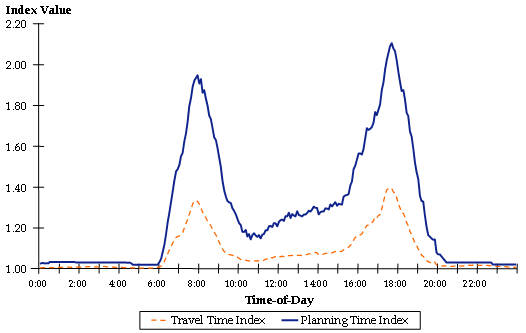
Source: Analysis of data from FHWA's Mobility Monitoring Program. The Planning Time Index is the 95th percentile Travel Time Index.
3. Changing Lifestyles, Changing Travel
As people move through life, two significant choices they make are where to live and where to work. These choices can change over time and influence where, when, and how much congestion occurs on highways. For example, a young couple just entering the job market may decide to live in an urban setting while older couples with children may choose to live in the suburbs. Often these suburbs are in formerly rural areas on the urban fringe, and are significant distances away from traditional downtown employment areas. The decision to move into these fringe areas is influenced by a number of factors — affordable housing, newer schools, more open space, and, in some cases, avoiding congestion close in to cities. In response, many employers are following, moving their business locations closer to where prospective employees live and taking advantage of lower land prices.
This ability of both residents and employers to move around the urban landscape has effects on congestion. First, by housing and jobs moving further out into the suburbs, individuals can keep their travel times to work relatively stable. However, these new travel patterns also result in congestion on roadways that were previously only lightly used. Of course, some folks will still choose the longer commute into central areas — this will cause an increase in congestion on those already crowded roads.
The stability in work trip travel times may be a temporary condition. Recent evidence from the decennial Census suggests that even those who live and work in the suburbs may be experiencing increased travel times to work (Figure 3.15).
Figure 3.15 Average Travel Times to Work
1980-2000
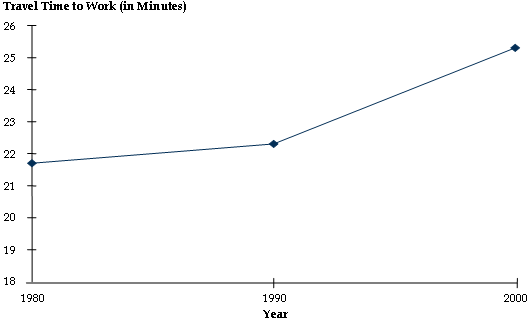
Source: Census Journey-to-Work data, as compiled by Alan Pisarski.
Between 1980 and 1990, work travel times were relatively stable, but have increased by three minutes per trip between 1990 and 2000. While three minutes per trip (six minutes per day for trips to and from work) may not seem like a lot, it is 25 extra hours each year. The increase indicates that we may not be able to escape congestion just by spreading our activities to larger areas. Also, as shown earlier, as congestion grows, so does the unreliability of travel times. Therefore, as congestion builds, commuters have to budget even more time onto their trips if they do not want to be late.
4. Congestion and Trucking: How Congestion Costs Us All
Congestion has real costs for all travelers, including truckers (both long-haul and local pickup and delivery), household and business service providers (such as plumbers, computer technicians, police, and ambulance services), and personal travel (such as commuters, vacationers, and shoppers). Congestion causes more fuel to be used and more emissions to be produced. The extra time spent in congestion causes service providers to make fewer calls per day, leading to higher prices for consumers; this is particularly important for emergency medical, fire, and police services which may be unnecessarily delayed from attending to medical, crime, and disaster situations. Companies with production schedules timed to take advantage of trucks delivering components to an assembly line as they are needed must instead plan for items to arrive early. This consumes space and inventory, expending resources that could otherwise be spent on productive activity. For personal travelers, congestion "steals" time that could be put to better use in the workplace or for social or recreational purposes.
In recent decades, the freight transportation system has been in transition from an era focused primarily on system construction toward an era that will focus increasingly on system optimization. Past efforts at developing the transportation infrastructure were oriented around system construction. The railroads in the 19th century and the highway system in the twentieth century connected all parts of the nation, and opened up markets for moving freight and passengers. Today, these systems are extensive and mature. Ports, airports, and other freight systems have been developed, and technological and management change has increasingly focused on optimizing the use of available physical assets. Those mature assets require large expenditures of resources to maintain and preserve asset conditions, meaning that fewer resources are available to build new capacity.
Freight transportation has gone through many changes over the past 20 years as it has adapted to changes in business practices. Within this new operating environment, freight operations and productivity have been optimized to work closely with other aspects of business activity. Deregulation has resulted in excess capacity being eliminated from the highway and rail freight systems. Intermodal services and facilities have revolutionized international trade. Ports and airports have seen services and demand grow rapidly. Freight services are now more efficient and in many cases lower in cost (in constant dollars) than in previous decades. But the elimination of excess capacity has resulted in systems with less redundancy and less ability to withstand shocks or disruptions. Congestion is growing on many key freight segments of the transportation system, and congestion can drastically reduce the productivity of the overall freight network. The delay caused by congestion could vastly increase the costs of those freight movements that are today managed to exacting schedules.
Time is literally money for trucking interests. As shown in Figure 3.16, a direct linkage exists between transportation investment, travel conditions (congestion and reliability) and economic productivity. For trucking, two key trends identified above will have a substantial impact on the total cost of moving freight:
- As congestion spreads into the midday period, which is the peak travel period for trucks, more direct costs will be incurred; and
- Reliability – for trucks, the ability to hit delivery windows predictably will decrease and will add even more costs as firms struggle to optimize delivery schedules. This is especially a problem for truckers who must meet "just-in-time" delivery schedules set by shippers and manufacturers.
Figure 3.16 Economic Effects of Transportation
1980-2000
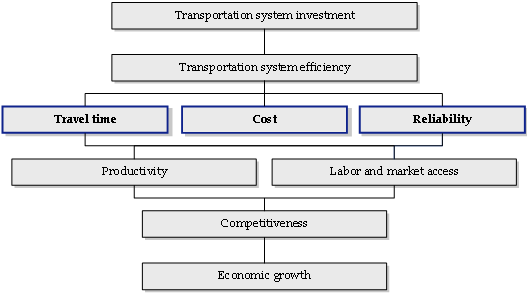
![]()
In 1999, purchases of transportation-related goods and services accounted for 10.6 percent ($980 billion) of GDP. The diverse and extensive list of purchases includes the services of for-hire freight carriers, vehicles, parts, maintenance, and fuel. Only housing, health care, and food account for a greater share of GDP.21 Transportation accounts for a share of the final price of a product, ranging from one percent to 14 percent, depending on the commodity and distance moved.22 Thus, changes in the physical condition and operating characteristics of the highway system can have a major effect on the final price of goods and services. Improvements in freight transportation productivity (such as reduced costs due to congestion) contribute to the economy by helping the United States remain competitive in international trade.
All of this adds up to a staggering amount of costs imposed on travelers by congestion. The Texas Transportation Institute estimates that in 75 of the largest U.S. cities in 2001, $69.5 billion dollars are wasted in time and fuel costs.23 (The costs are a composite of automobile and truck travel costs in urban areas.) The time value costs used for trucks in this calculation are conservative — they include only the cost of truck operating time, primarily the cost of drivers' wages and equipment. The value of the cargo and the response of firms to higher transportation costs are not included, yet recent work suggests these costs can be significant. These costs include:
- Foregone Investment Opportunities – Higher transportation costs due to congestion reduce a firm's ability to invest in making more products, improve product quality, and introduce new products; and
- Decreases in Regional Employment or Decreases in the Rate of Growth of Regional Income – Higher transportation costs are passed onto other sectors of the economy and hinder general economic efficiency.24
15 Schrank, D. and Lomax, T., 2003 Annual Urban Mobility Report, Texas Transportation Institute.
16 In most metropolitan areas, the idea of "rush hour" is obsolete — congestion happens for multiple hours on both morning and evening weekdays.
17 Travel Time index is the ratio of actual travel time for a trip compared to the "ideal" travel time for a trip. Thus, a Travel Time Index of 1.3 indicates that the trip takes 30 percent longer than it would under "ideal" or uncongested conditions.
18 Caitlin Liu. Los Angeles Times. "SigAlert on the Roadway to Love; Traffic Sometimes Dictates the Route of Romance in Los Angeles." February 13, 2004.
19 The Freight Analysis Framework provided the data for Figures 3.9 and 3.10.
20 Texas Transportation Institute and Battelle Memorial Institute, International Border Crossing Truck Travel Time for 2001, prepared for Office of Freight Management and Operations, FHWA, April 2002.
21 Status of the Nation's Highways, Bridges, and Transit: 2002 Conditions and Performance Report.
22 U.S. Department of Transportation, Bureau of Transportation Statistics, Transportation Satellite Accounts.
23 Schrank, D. and Lomax, T., 2003 Annual Urban Mobility Report, Texas Transportation Institute.
24 ICF Consulting, HLB Decision Economics, and Louis Berger Group, Freight Benefit/Cost Study: Capturing the Full Benefits of Freight Transportation Improvements: A Non-Technical Review of Linkages and the Benefit/Cost Analysis Framework, May 11, 2001.
Previous |Table of Contents | Next